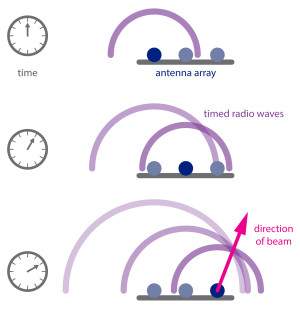Beamforming

A technology that uses an array of smaller antennas acting as one, that can "aim" the sent signal — or reception sensitivity — in a specific spatial direction without physically moving the antenna. To achieve this, the timing of signals are staggered across the antennas in the array. Each individual antenna transmits/receives the same relatively weak signal in all directions, but where all of the individual signals converge, a full-strength signal is present, extending in one specific direction from the array. Adjusting the timing changes the direction of the signal.
Beamforming can improve both the capacity and range of a wireless network.
Beamforming antenna arrays can be used on both ends of a cellular connection: phone and "towers". On the tower side, antennas capable of full beamforming are generally larger than traditional antennas, and can operate at a variety of frequencies.
Inside phones, beamforming antennas can actually be much smaller than traditional antennas, but are only used in the very highest frequency bands, known as millimeter wave (mmWave), used with 5G technology.
See: mmWave
Last updated Aug 14, 2018 by Rich Brome
Editor in Chief Rich became fascinated with cell phones in 1999, creating mobile web sites for phones with tiny black-and-white displays and obsessing over new phone models. Realizing a need for better info about phones, he started Phone Scoop in 2001, and has been helming the site ever since. Rich has spent two decades researching and covering every detail of the phone industry, traveling the world to tour factories, interview CEOs, and get every last spec and photo Phone Scoop readers have come to expect. As an industry veteran, Rich is a respected voice on phone technology of the past, present, and future.



